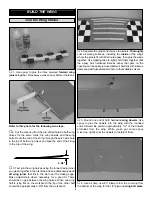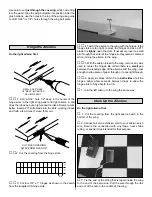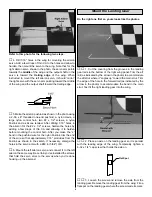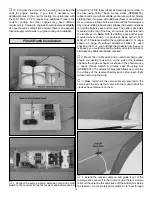
❏
4. Trim the molded plastic
turtledeck
to fit the fuse, then
temporarily fit it into position. Trim the cockpit coaming to
accommodate the turtledeck. If you plan to route the
receiver antenna through the top of the fuse, cut a hole in
the turtledeck to pass the antenna. Glue the turtledeck to the
fuse with thin CA.
❏
5. If you prefer, you can glue the coaming to the fuse with
thin CA, but the coaming stays put by itself, so it isn't really
necessary to glue it.
❏
6. Glue the windscreen to the fuse. If
great
care is used
and it is applied
sparingly
, thin CA can be used for this. If too
much thin CA is used, fogging of the canopy and covering will
be the result. Another type of adhesive recommended is J &
Z Products Z R/C 56 canopy glue (JOZR5007), but it dries in
a few hours, so the canopy will have to be taped into position
while the glue is drying.
❏
7. Apply Great Planes 1/4" white Kwik Stripe (GPMQ1610)
striping tape around the base of the windscreen where it meets
the fuse. For an added touch, apply 1/8" chrome striping tape
(GPMQ10884) around the aft edge of the windscreen.
❏
8. Assemble, paint, then glue a pilot in the cockpit. We
used a Williams Bros. #62500 1/4-scale Standard pilot
(WBRQ2625) with 1/4" balsa sticks glued between the base
of the pilot and the cockpit floor to raise him 1/4".
❏
9. Cut out the molded
dorsal fin
, then glue it into position
with thin CA as shown in the photo.
❏
1. Turn on the transmitter and receiver and center the
trims. If necessary, remove the servo arms from the servos
and reposition them so they are centered.
❏
2. If necessary, adjust the clevises on the pushrods so
the control surfaces are centered.
❏
3. Make certain that the control surfaces and the
carburetor respond in the correct direction as shown in the
diagram above. If any of the controls respond in the
opposite direction, change their direction by using the servo
reversing feature in your transmitter.
Note:
Due to the fact
that the elevator pushrods are connected to opposite sides
of the elevator servos, the servos must be mixed
electronically (not with a “Y” connector).
Use a Great Planes AccuThrow
™
(or a ruler) to accurately
measure and set the control throw of each control surface
as indicated in the chart that follows. If your radio does not
have dual rates, we recommend setting the throws at the
low rate setting.
NOTE:
Throws are measured at the
widest part
of the
elevators, rudder and ailerons. You will probably not be able
to achieve the recommended rudder control throws
mechanically (by changing the mounting locations of the
cables on the servo arm and rudder). You will have to use
the ATV in your transmitter. In our transmitter, we found it
necessary to turn the rudder ATV down to about 70% to
arrive at the correct throw.
Set the Control Throws
CARBURETOR WIDE OPEN
RUDDER MOVES RIGHT
LEFT AILERON MOVES DOWN
RIGHT AILERON MOVES UP
ELEVATOR MOVES UP
4-CHANNEL
TRANSMITTER
(STANDARD MODE 2)
4-CHANNEL RADIO SETUP
TRANSMITTER
4-CHANNEL
TRANSMITTER
4-CHANNEL
TRANSMITTER
4-CHANNEL
Check the Control Directions
GET THE MODEL READY TO FLY
19










































